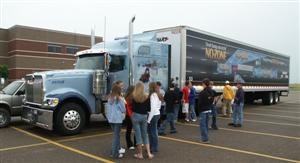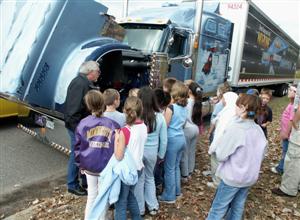FEBRUARY 2007 TRUCKER TALK
EDUCATION
NOT LEGISLATION
By Writers and Owner
Operators Rod & Kim Grimm
Can you really legislate safety? Will a law that says you have to put a device on your truck to limit its speed to 68 mph actually make you a safer driver? How about putting black boxes in trucks that record your every move? Will these recording devices really make our highways safer, or will they just be another stumbling block for an industry that is already struggling with a shortage of good drivers? Some of the veteran drivers we spoke to about these issues said they are on the verge of quitting because of the regulations, and that some (or all) of these new requirements might push them over the top. And what a shame that would be.
For years, Rod and I have said that we (as an industry) should be educating the public about sharing the road with big trucks. Trucker Buddy is a great program that helps do exactly that. But if they want to make a law, how about forcing students to learn about big trucks by making it a required part of all driving classes? Years ago we took our truck to the local high school in our home state of Iowa to introduce the Drivers’ Ed students to trucks. It was the first time the teacher had ever been in a truck. You can’t teach about trucks with movies and books. Nothing teaches a new driver more about trucks than actually letting the students sit in the driver’s seat, look out over the hood, peer into the mirrors and realize, “It’s a long way to the back of this thing.” Putting something small like a compact car or a bicycle in the blind spot really illustrates to these kids the challenges truck drivers face when out on the road.
I remember the video when I was in school that showed the cars left front fender being crunched by the trailer of a long combination attempting to make a wide right turn. Everybody thought it was funny, but I’m not sure those scenes made any of us stay back from the intersection to give a truck enough room to get around the corner without that happening. Taking a truck and trailer to the school and giving a demonstration in the parking lot, showing why a truck needs all that room to complete a turn, would be better than any silly video. Think about it – do you really want your first car crunched?
Back in school, we were also shown the graphic video of the car and truck wreck – as usual, the car was the big loser. That hasn’t necessarily made people drive any safer around trucks either. Many people think trucks are merely “obstacles” to be avoided or cut in front of – off they go on their merry little way until something happens and you hear, “I didn’t see you.” How can so many car drivers not see something as large as a big rig?
 The
NO ZONE campaign has been a good educational vehicle for Harvey Zander,
who occasionally pulls a NO ZONE trailer and takes it to Drivers’ Ed classes,
sharing years of safe driving experience and giving hands-on truck education
(see photos). For those that don’t know, the NO ZONE campaign is an ongoing
effort to educate the motoring public about blind spots and big trucks.
These school visits are good for the kids, but Harvey hopes they take
what they’ve learned home and share the information with their parents.
Maybe they can be made aware of unsafe practices they’ve been doing for
years. There are laws that make parents put their kids in car seats or
buckle them up, but none to make them drive safe around a truck with three
little kids in the car. We worry about kids when we see their parent do
something incredibly stupid in front of our truck.
The
NO ZONE campaign has been a good educational vehicle for Harvey Zander,
who occasionally pulls a NO ZONE trailer and takes it to Drivers’ Ed classes,
sharing years of safe driving experience and giving hands-on truck education
(see photos). For those that don’t know, the NO ZONE campaign is an ongoing
effort to educate the motoring public about blind spots and big trucks.
These school visits are good for the kids, but Harvey hopes they take
what they’ve learned home and share the information with their parents.
Maybe they can be made aware of unsafe practices they’ve been doing for
years. There are laws that make parents put their kids in car seats or
buckle them up, but none to make them drive safe around a truck with three
little kids in the car. We worry about kids when we see their parent do
something incredibly stupid in front of our truck.
Safety really boils down to driver responsibility, and you can’t legislate that. Look at all the truck accidents that happen at docks and truck stop parking lots – if nobody sees it, the driver just leaves (and even when people do see it, they still just drive off instead of taking responsibility for what they did). You can put a speed limiter on a truck and it can still go 68 mph through a construction zone, down a steep mountain grade or on a crowded city street. It’s the driver that makes a truck safe (or unsafe).
Many companies are now looking outside the country to recruit new drivers. In our experience, we are seeing (and hearing) more and more foreign drivers. Once at a dock, a driver, in very broken English, told us to give him two of our load locks. “I take them,” he said. We politely said, “No!” This guy obviously didn’t have a clue. Many of these foreign recruits speak little or no English. We often wonder how they read our road signs and maps. How did they get their license? Going across Wyoming one day, I tried to tell a driver that the right rear brake chamber on his trailer was dragging on the ground. The driver behind me also tried. After getting no response, we concluded that he’d figure it out pretty fast when it broke off and his brakes set. I know the industry needs drivers, but the way they’re going about finding them might not make for the safest roads. I watch the way some of these guys drive and it scares me to death.
One of the things legislators are considering is putting black boxes in trucks that have bad compliance records. Once they get started, do you really think that’s where it will stop? I doubt it will stop until they are in every truck, in the name of safety. I’m all for making the roads safe, but I disagree with how the people in power are going about doing it (without knowledge). Why not take up offers to ride with drivers and see first-hand the real problems, before making laws that don’t make sense or work in the real world. There is no one-size-fits-all law for the trucking industry.
One of our big pet peeves is the commercials that car companies use, showing that sexy little sports car flying down a winding, narrow road – and snow, no problem. Some people see these commercials and obviously think they can really drive like that, because we see them attempting these ridiculous moves on the freeway, in traffic and on icy, snowy roads. This brings me to my next point – speed limiters on trucks. One driver I talked to suggested making these speed limiters all inclusive – put them on all cars as well as all commercial vehicles. Can you imagine the public outrage at that idea?
We already have problems with split speed limits and lane restrictions, but add to that slow trucks that can’t pass or get up a hill and the roads would really get screwed up. One day, out on the flat in Nebraska, we were stuck behind one truck attempting to pass another truck for over 5 miles. The one passing would not slow down and get back behind the truck he was trying to overtake, and the other truck would not slow down a little and let him over. I think you would see a lot more of that kind of situation with speed limiters. The problem would really rear its ugly head on mountain grades with restricted lanes (we’ll all have to slow down to 20 mph and just crawl up the hills together, loaded or not, because we won’t have any other choice).
Common sense tells you that split speed limits are not really safer, but they do make the state a lot of money. I haven’t found the statistics about how many accidents are caused by split speed limits, but I bet it is a significant percentage. The road is the safest when all of the traffic lanes are flowing at the same speed, not when one vehicle (a car) is allowed to go too fast and the other (a truck) is forced to go too slow – that is a recipe for disaster.
Talking with drivers that own their own trucks, we asked them if these new requirements would make them consider getting off the road. The answer was almost a unanimous, “Yes.” One driver told us that he was really glad that he’s not that far away from retirement. He said that he would probably keep his truck but try to find something really local to do with it. Another driver told us that he would stay on the road, but he thought that limiting trucks to 68 mph was too slow and that it might lead to more rear-end accidents. Drivers of cars, going faster than 68 mph and not paying attention, could find themselves coming up very quickly on a slow truck, and the result could be ugly.
Another driver told us that if these proposed regulations come down the pike the way it looks like they will, he will definitely be going home. All the drivers we talked to are concerned with safety, and all of them run their trucks in a very safe manner. They have the “it’s mine and I do care” attitude (which is good). A younger driver that we spoke to, with at least 30 years of driving still ahead of him, also said that he would quit running long-haul and find something to do near home. This would certainly not be his first career choice – not at all – but it comes down to how much you are willing to put up with. And many of these guys (and gals) are about at the end of their rope.
Many of us chose trucking as a career because of the adventure, the freedom and the fun. But little by little, they are taking all the fun out of it. Most of the people I spoke to agreed that education and personal responsibility is the real answer, in regards to making our roads safe. I wonder how much some people might regret what they wished for if these laws become reality. Then, it would be a little late to complain about those slow trucks holding up traffic.
Several activist groups are attempting to convince the legislators that these “safety devices” are going to help. I beg to differ. Quality people will be the only real safety device for our industry. And if these new things force some of our industry’s best drivers to get off the road, then the roads will just get even more dangerous. Why? Because who will replace those veterans that got fed up? Well, more new, inexperienced drivers, of course.
Copyright
© 2006 10-4 Magazine and Tenfourmagazine.com
PO Box 7377 Huntington Beach, CA, 92615 tel. (714) 378-9990 fax
(714) 962-8506

